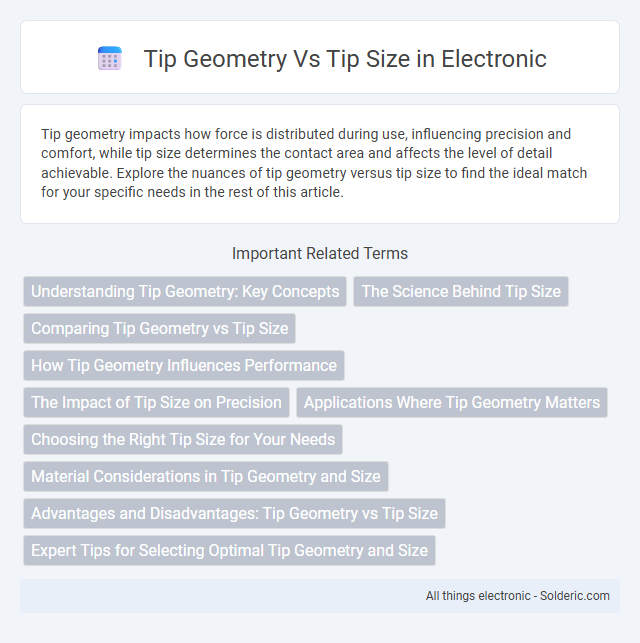Tip geometry impacts how force is distributed during use, influencing precision and comfort, while tip size determines the contact area and affects the level of detail achievable. Explore the nuances of tip geometry versus tip size to find the ideal match for your specific needs in the rest of this article.
Comparison Table
| Aspect | Tip Geometry | Tip Size |
|---|---|---|
| Definition | Shape and contour of the tip's edge | Physical dimensions of the tip, typically length or diameter |
| Impact on Performance | Affects precision, cutting angle, and control | Influences reach, accessibility, and stability |
| Common Types | Chisel, conical, bevel, rounded | Small, medium, large; measured in millimeters or inches |
| Application | Designed for specific tasks requiring certain edge profiles | Chosen based on task space and required maneuverability |
| Material Interaction | Controls how the tip engages with material | Determines contact area and pressure distribution |
Understanding Tip Geometry: Key Concepts
Tip geometry encompasses the detailed shape and structural features of a tool's tip, influencing cutting efficiency and precision. Different tip sizes also play a critical role by determining the contact area and affecting parameters such as force distribution and heat generation. Optimizing both tip geometry and size is essential for enhancing performance in applications like machining, medical devices, and microelectronics.
The Science Behind Tip Size
Tip geometry significantly influences the effectiveness of your tools, with tip size playing a crucial role in precision and durability. Smaller tip sizes offer finer detail and accuracy, ideal for intricate work, while larger tips provide enhanced strength and longer wear for heavy-duty tasks. Understanding the science behind tip size ensures you select the perfect balance for your specific application, optimizing performance and results.
Comparing Tip Geometry vs Tip Size
Tip geometry significantly influences the precision and control of your tools, affecting factors like contact area and pressure distribution. While tip size determines coverage and accessibility to tight spaces, the shape and angle of the tip enhance functionality by optimizing performance for specific tasks. Understanding both tip geometry and size allows you to select the ideal tool for accuracy and efficiency.
How Tip Geometry Influences Performance
Tip geometry significantly affects cutting efficiency, wear resistance, and precision in machining processes. Variations in angles, radius, and shape determine chip formation, heat dissipation, and tool strength, directly impacting the quality of your finished workpiece. Understanding how tip geometry influences performance allows you to select the optimal configuration for specific materials and operational conditions.
The Impact of Tip Size on Precision
Tip size directly influences precision by determining the level of detail and control achievable during application or measurement. Smaller tip sizes enable finer, more accurate manipulations, essential for tasks requiring high resolution and minimal error margins. Conversely, larger tips offer broader coverage but reduce the ability to perform delicate, precise actions critical in fields like microelectronics and biomedical procedures.
Applications Where Tip Geometry Matters
Tip geometry significantly influences precision and efficiency in applications like electronics soldering, where fine, tapered tips provide control for delicate components. In contrast, larger, chisel-shaped tips suit heavy-duty tasks such as plumbing or metalwork, offering better heat transfer and durability. Choosing the right tip geometry ensures your work meets the specific demands of the application, enhancing quality and performance.
Choosing the Right Tip Size for Your Needs
Selecting the appropriate tip size depends on the precision required and the application's scale, with smaller tips offering finer detail and larger tips providing broader coverage. Tip geometry influences how efficiently the tool interacts with the workpiece, affecting accuracy, control, and comfort during use. Optimal performance is achieved by aligning tip size and shape with task-specific demands, ensuring both effectiveness and durability.
Material Considerations in Tip Geometry and Size
Material properties significantly influence the optimal tip geometry and size for various applications, as harder materials may require smaller, sharper tips to achieve precision without excessive wear. Softer or more ductile materials often benefit from larger, blunter tips that reduce deformation and increase durability. Your choice of tip must align with the material's hardness, brittleness, and thermal conductivity to ensure efficiency and longevity in performance.
Advantages and Disadvantages: Tip Geometry vs Tip Size
Tip geometry influences precision and durability by determining the contact area and pressure distribution, while tip size affects accessibility and surface interaction on delicate or intricate tasks. Smaller tip sizes offer finer detail but may wear out faster, whereas larger tips provide stability but can limit maneuverability in tight spaces. Understanding your specific application helps balance the trade-offs between tip geometry and size for optimal performance.
Expert Tips for Selecting Optimal Tip Geometry and Size
Selecting the optimal tip geometry and size significantly impacts precision and efficiency in applications such as soldering or 3D printing. You should consider the specific task requirements: finer tip sizes offer detailed work while larger geometries enhance heat transfer or material deposition speed. Expert tips recommend balancing tip shape and size based on the target material's thermal properties and the complexity of the design to ensure consistent, high-quality results.
tip geometry vs tip size Infographic

 solderic.com
solderic.com